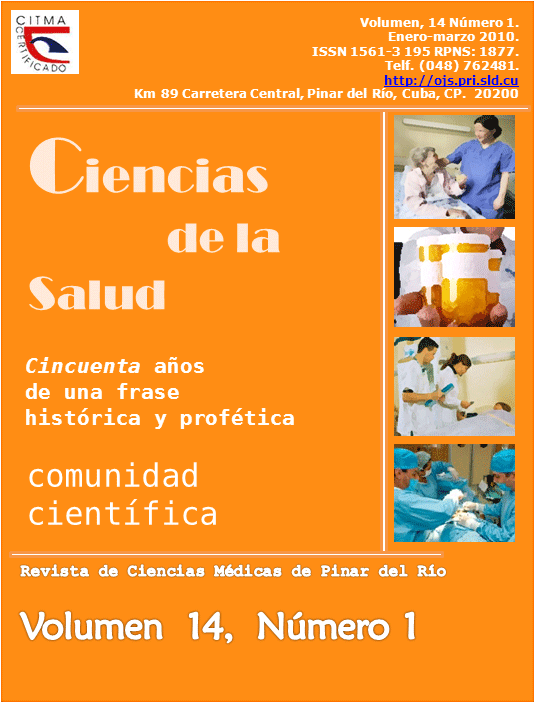Situs inversus totalis: a case report
Abstract
A 51 years old patient (MCG) attends to the family doctor's office for a routine check-up. An electrocardiogram is indicated and is transferred to an Internal Medicine Center at "Elena Fernandez de Castro" University Outpatient Clinic, Los Palacios municipality. The patient was diagnosed for first time with situs inversus totalis. To diagnose this entity clinical methods and imaging studies were used. Situs inversus goes unnoticed in the majority of the cases. The diagnosis is incidentally carried out during the transoperative period or as imaging findings, that is why, it is necessary to write an adequate clinical history with a detailed physical examination when suspecting, corroborating it later by means of imaging procedures (thoracic x-ray, ultrasound and computerized axial tomography), making the patient knows the disorder as well as informing it to the health personnel that assist the patient.Downloads
References
1. Wilhelm AM, Holbert J M. Situs Inversus. Medicine Specialties. Medicine from WEBMD. Last Updated 2003; Secc. 2-1.
2. Melchor González JM, Pérez García AR, Torres-Vista M, Rodríguez Brambila VR. Situs Inversus. Reporte de 2 casos. Hosp. Juárez Mex. Circ Ciruj 2000; 68(2): 72-75.
3. Christian K, Targarona EM, Alonso V, Moya I, Bendahan GE, Cherichetti C, Balagué C y otros. Cirugía laparoscópica y situs inversus. Revisión de la literatura y presentación de un caso de sigmoidectomía por diverticulitis. Cir Esp 2003;73(6):381-4
4. Baillie M. An account of remarkable transposition of viscera. Phil Trnas 1788; 78: 350-363.
5. Echenique Elizondo M, Urkia Exabe JM. Situs inversus totalis. Primera descripción científica realizada durante la ilustración en México. Universidad del país Vasco. Unidad Docente de Medicina de San Sebastián. Ediciones Doyma. Rev. Cirug Esp 2001; 70(5): 247-50.
6. Paublo M Mario, Bustos V Juan Carlos, Ramírez H Pedro. Diagnóstico prenatal de situs inversus totalis. Rev. chil. obstet. ginecol. [revista en la Internet]. 2002 [citado 6 de Julio de 2009]; 67(6): 494-497. Disponible en: http://www.scielo.cl/scielo.php?script=sci_arttext&pid=S0717-75262002000600011&lng=es
7. Ortega A R. Caso clínico de situs inversus a propósito de 1 caso. Rev latido de la Sociedad Boliviana de Cardiología 2003; disponible en: http://www.Bago.com.bo
8. Izquierdo M, Avellaneda A. Situs Inversus. Descripción en lenguaje coloquial. Asociación Española para el Registro y Estudio de las Malformaciones Congénitas. (ASEREMAC) Febrero-2004.
9. Rivera L. Caso clínico. Situs inversus. Rev Soc Bol Ped 2003; 42 (3):175-6:
10. Toirac Lamarque E. Bronquiectasia. En: Roca Goderich R. Temas de Medicina Interna. Editorial Ciencias Médicas 2002; 52:p. 133-38.
Published
How to Cite
Issue
Section
License
Authors who have publications with this journal agree to the following terms: Authors will retain their copyrights and grant the journal the right of first publication of their work, which will be publication of their work, which will be simultaneously subject to the Creative Commons Attribution License (CC-BY-NC 4.0) that allows third parties to share the work as long as its author and first publication in this journal are indicated.
Authors may adopt other non-exclusive license agreements for distribution of the published version of the work (e.g.: deposit it in an institutional telematic archive or publish it in a volume). Likewise, and according to the recommendations of the Medical Sciences Editorial (ECIMED), authors must declare in each article their contribution according to the CRediT taxonomy (contributor roles). This taxonomy includes 14 roles, which can be used to represent the tasks typically performed by contributors in scientific academic production. It should be consulted in monograph) whenever initial publication in this journal is indicated. Authors are allowed and encouraged to disseminate their work through the Internet (e.g., in institutional telematic archives or on their web page) before and during the submission process, which may produce interesting exchanges and increase citations of the published work. (See The effect of open access). https://casrai.org/credit/



